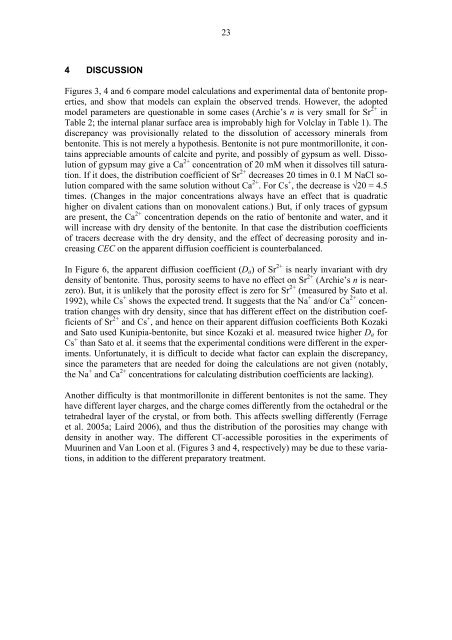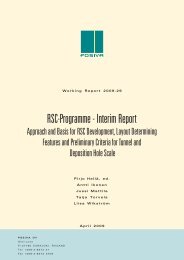234 DISCUSSIONFigures 3, 4 <strong>and</strong> 6 compare model calculations <strong>and</strong> experimental data <strong>of</strong> bentonite properties,<strong>and</strong> show that models can expla<strong>in</strong> the observed trends. However, the adoptedmodel parameters are questionable <strong>in</strong> some cases (Archie’s n is very small for Sr 2+ <strong>in</strong>Table 2; the <strong>in</strong>ternal planar surface area is improbably high for Volclay <strong>in</strong> Table 1). Thediscrepancy was provisionally related to the dissolution <strong>of</strong> accessory m<strong>in</strong>erals frombentonite. This is not merely a hypothesis. <strong>Bentonite</strong> is not pure montmorillonite, it conta<strong>in</strong>sappreciable amounts <strong>of</strong> calcite <strong>and</strong> pyrite, <strong>and</strong> possibly <strong>of</strong> gypsum as well. Dissolution<strong>of</strong> gypsum may give a Ca 2+ concentration <strong>of</strong> 20 mM when it dissolves till saturation.If it does, the distribution coefficient <strong>of</strong> Sr 2+ decreases 20 times <strong>in</strong> 0.1 M NaCl solutioncompared with the same solution without Ca 2+ . For Cs + , the decrease is √20 = 4.5times. (Changes <strong>in</strong> the major concentrations always have an effect that is quadratichigher on divalent cations than on monovalent cations.) But, if only traces <strong>of</strong> gypsumare present, the Ca 2+ concentration depends on the ratio <strong>of</strong> bentonite <strong>and</strong> water, <strong>and</strong> itwill <strong>in</strong>crease with dry density <strong>of</strong> the bentonite. In that case the distribution coefficients<strong>of</strong> tracers decrease with the dry density, <strong>and</strong> the effect <strong>of</strong> decreas<strong>in</strong>g <strong>porosity</strong> <strong>and</strong> <strong>in</strong>creas<strong>in</strong>gCEC on the apparent diffusion coefficient is counterbalanced.In Figure 6, the apparent diffusion coefficient (D a ) <strong>of</strong> Sr 2+ is nearly <strong>in</strong>variant with drydensity <strong>of</strong> bentonite. Thus, <strong>porosity</strong> seems to have no effect on Sr 2+ (Archie’s n is nearzero).But, it is unlikely that the <strong>porosity</strong> effect is zero for Sr 2+ (measured by Sato et al.1992), while Cs + shows the expected trend. It suggests that the Na + <strong>and</strong>/or Ca 2+ concentrationchanges with dry density, s<strong>in</strong>ce that has different effect on the distribution coefficients<strong>of</strong> Sr 2+ <strong>and</strong> Cs + , <strong>and</strong> hence on their apparent diffusion coefficients Both Kozaki<strong>and</strong> Sato used Kunipia-bentonite, but s<strong>in</strong>ce Kozaki et al. measured twice higher D a forCs + than Sato et al. it seems that the experimental conditions were different <strong>in</strong> the experiments.Unfortunately, it is difficult to decide what factor can expla<strong>in</strong> the discrepancy,s<strong>in</strong>ce the parameters that are needed for do<strong>in</strong>g the calculations are not given (notably,the Na + <strong>and</strong> Ca 2+ concentrations for calculat<strong>in</strong>g distribution coefficients are lack<strong>in</strong>g).Another difficulty is that montmorillonite <strong>in</strong> different bentonites is not the same. Theyhave different layer charges, <strong>and</strong> the charge comes differently from the octahedral or thetetrahedral layer <strong>of</strong> the crystal, or from both. This affects swell<strong>in</strong>g differently (Ferrageet al. 2005a; Laird 2006), <strong>and</strong> thus the distribution <strong>of</strong> the porosities may change withdensity <strong>in</strong> another way. The different Cl - -accessible porosities <strong>in</strong> the experiments <strong>of</strong>Muur<strong>in</strong>en <strong>and</strong> Van Loon et al. (Figures 3 <strong>and</strong> 4, respectively) may be due to these variations,<strong>in</strong> addition to the different preparatory treatment.
24Table 4. Specific volume <strong>and</strong> relative density <strong>of</strong> water <strong>in</strong> the <strong>in</strong>terlayer space <strong>of</strong>montmorillonite. The specific volume is calculated from the measured (or calculated)number <strong>of</strong> water molecules per unit cell <strong>and</strong> the volume <strong>of</strong> the <strong>in</strong>terlayer space(a×b×(d 001 – c * )), where c * is the thickness <strong>of</strong> the TOT layer (10 -9 nm for divalent cations<strong>and</strong> K + , 0.96×10 -9 nm for lighter alkalis). The density is relative to pure water witha specific volume <strong>of</strong> 3.00×10 -29 m 3 /mol H 2 O.Authormol H 2 O/unit celld 001(nm)V sp(10 -29 m 3 /mol H 2 O)relativedensityCation(no <strong>of</strong> waterlayers)MethodPitteloud, 2000 3.9 1.20 2.90 1.03 Na (1W)NeutrondiffractionFerrage, 20070.5 1.17 0.16 0.19 Ca (1W) XRD3 1.26 4.10 0.73 Ca (1W)5.5 1.50 4.26 0.70 Ca (2W)7 1.52 3.53 0.85 Ca (2W)2.8 1.23 4.56 0.66 Na (1W) XRDFerrage,4.5 1.26 3.10 0.96 Na (1W)2005b6.4 1.54 4.29 0.70 Na (2W) XRD7 1.55 3.95 0.76 Na (2W)Karaborni,19964.30 1.25 3.19 0.94 Na (1W) Molecular7.60 1.55 3.67 0.81 Na (2W)dynamicscalculations9.10 1.83 4.52 0.66 Na (3W)However, even if the <strong>in</strong>terlayer spac<strong>in</strong>g would be known, the density <strong>of</strong> the water thereis not. Changes <strong>in</strong> water content <strong>and</strong> thickness <strong>of</strong> the <strong>in</strong>terlayer space have been measuredby weigh<strong>in</strong>g <strong>in</strong> comb<strong>in</strong>ation with XRD <strong>and</strong> neutron scatter<strong>in</strong>g, <strong>and</strong> can be calculated,<strong>in</strong> pr<strong>in</strong>ciple, by molecular dynamics simulations. Table 4 shows values <strong>of</strong> <strong>in</strong>terlayerthickness <strong>and</strong> water content from the literature. The XRD measurements are done byvary<strong>in</strong>g the relative humidity (RH) <strong>and</strong> show hysteresis, with smaller d 001 spac<strong>in</strong>g uponwett<strong>in</strong>g than with dry<strong>in</strong>g. Relative densities from Cases et al. (1992) <strong>and</strong> Bérend et al.(1995) (not <strong>in</strong> Table 4) average to about 0.65 for the 1-layer hydrate at a relative watervaporpressure <strong>of</strong> 0.4, <strong>and</strong> about 0.8 for the 2-layer hydrate, similar to the data <strong>of</strong>Ferrage et al. (2005b, 2007) listed <strong>in</strong> Table 4. In between 0 <strong>and</strong> ~90 % RH, four levelscorrespond with the completely dehydrated m<strong>in</strong>eral, <strong>and</strong> 1-, 2-, or 3-layer hydrates withNa + as <strong>in</strong>terlayer cation (Cases et al. 1992; Bérend et al. 1995; Ferrage 2005b, 2007). Inbetween, the spac<strong>in</strong>g <strong>and</strong> number <strong>of</strong> water molecules per water-layer varies gradually,suggest<strong>in</strong>g mixed-layer formation <strong>and</strong> a complicated distribution <strong>of</strong> the water over hydrationwater associated with the exchangeable cation <strong>and</strong> free water (Ferrage 2007).Table 4 shows that the density <strong>of</strong> water <strong>in</strong> the <strong>in</strong>terlayer space is smaller than <strong>of</strong> bulkwater, except for the value extracted from Pitteloud et al. (2000). When spac<strong>in</strong>g <strong>in</strong>creases,it approaches 1, but not <strong>in</strong> the MD calculations <strong>of</strong> Karaborni et al. (1996). The XRDresults are more consistent <strong>and</strong> show that water starts with hydrat<strong>in</strong>g the cation <strong>and</strong> thatthe structure exp<strong>and</strong>s then slightly. With <strong>in</strong>creas<strong>in</strong>g humidity, <strong>and</strong> as more water entersthe <strong>in</strong>terlayer space (displac<strong>in</strong>g the gas molecules from the laboratory atmosphere if notpumped vacuum), the relative density <strong>in</strong>creases until a threshold value is reached wherethe structure converts from the 1- to the 2-layer hydrate. With Na + as exchangeable cat-
- Page 1 and 2: Working Report 2013-29A Review of P
- Page 3 and 4: 2Katsaus bentoniitin huokoisuuteen
- Page 5 and 6: 21 INTRODUCTIONBentonite is foresee
- Page 7 and 8: 42 POROSITY IN BENTONITELaboratory
- Page 9 and 10: 6t IL = 1.41×10 -9 - 4.9×10 -13
- Page 11 and 12: 8data are few and not very precise
- Page 13 and 14: 10Figure 4. (A): Anion-accessible p
- Page 15 and 16: 123 DIFFUSION IN BENTONITE: INTRODU
- Page 17 and 18: 14Dp,iDa,i (22)Rwhere R is the reta
- Page 19 and 20: 16In Equation (26) it is assumed th
- Page 21 and 22: 18Figure 7. The effective diffusion
- Page 23 and 24: 20The equivalent fraction of an exc
- Page 25: 22Table 3. Concentrations, concentr
- Page 29 and 30: 26Furthermore, if the flux of Cs +
- Page 31 and 32: 286 ACKNOWLEDGMENTSComments of Urs
- Page 33 and 34: 30Doherty, J., 1994. PEST, Model-in
- Page 35 and 36: 32Muurinen, A., Karnland, O. and Le
















